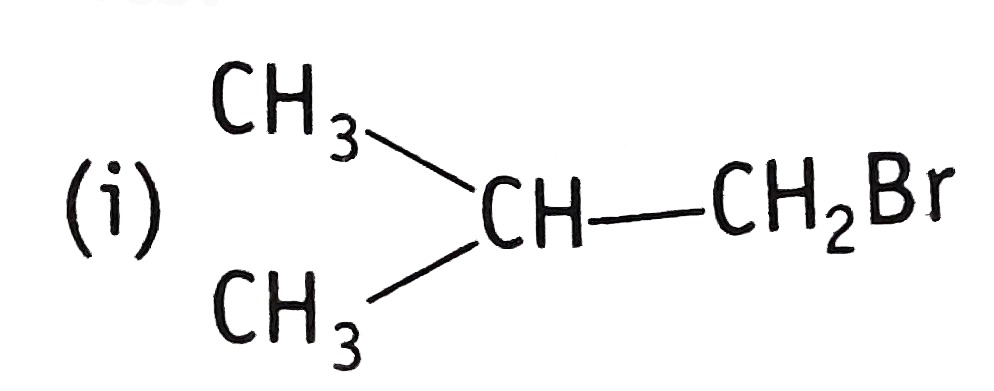Arrange the following alkyl halides in decreasing order of the rate or β-elimination reaction alcoholic KOH.
A. CH3−H∣C∣CH3−CH2Br
B. CH3−CH2−Br
C. CH3−CH2−CH2−Br
A>B>C
C>B>A
B>C>A
A>C>B
The correct Answer is:D
To arrange the given alkyl halides in decreasing order of the rate of β-elimination reaction with alcoholic KOH, we need to analyze the structure of each compound and the stability of the alkenes formed after the elimination reaction.
1. Identify the Alkyl Halides:
- A: CH3−CH(CH3)−CH2Br (1-bromo-2-methylpropane)
- B: CH3−CH2Br (ethyl bromide)
- C: CH3−CH2−CH2Br (1-bromopropane)
2. Understand β-Elimination:
- β-elimination involves the removal of a hydrogen atom from the β-carbon and the halogen (Br) from the α-carbon, resulting in the formation of an alkene. The stability of the alkene formed is crucial.
3. Determine the Substitution of the Alkenes:
- For compound A (1-bromo-2-methylpropane):
- The elimination will yield 2-methylpropene, which is a disubstituted alkene (two alkyl groups attached to the double bond).
- For compound B (ethyl bromide):
- The elimination will yield ethene, which is a non-substituted alkene (no alkyl groups attached to the double bond).
- For compound C (1-bromopropane):
- The elimination will yield propene, which is a monosubstituted alkene (one alkyl group attached to the double bond).
4. Compare the Stability of the Alkenes:
- Disubstituted alkenes are more stable than monosubstituted alkenes, which are more stable than non-substituted alkenes. Thus, the order of stability is:
- 2-methylpropene (disubstituted) > propene (monosubstituted) > ethene (non-substituted).
5. Rate of β-Elimination Reaction:
- The rate of β-elimination reaction is directly related to the stability of the alkene formed. Therefore, the order of the rate of reaction will be:
- A (1-bromo-2-methylpropane) > C (1-bromopropane) > B (ethyl bromide).
6. Final Arrangement:
- The decreasing order of the rate of β-elimination reaction with alcoholic KOH is:
- A > C > B.
Conclusion:
The correct order is:
1. A: CH3−CH(CH3)−CH2Br (1-bromo-2-methylpropane)
2. C: CH3−CH2−CH2Br (1-bromopropane)
3. B: CH3−CH2Br (ethyl bromide)
- A: CH3−CH(CH3)−CH2Br (1-bromo-2-methylpropane)
- B: CH3−CH2Br (ethyl bromide)
- C: CH3−CH2−CH2Br (1-bromopropane)
- β-elimination involves the removal of a hydrogen atom from the β-carbon and the halogen (Br) from the α-carbon, resulting in the formation of an alkene. The stability of the alkene formed is crucial.
- For compound A (1-bromo-2-methylpropane):
- The elimination will yield 2-methylpropene, which is a disubstituted alkene (two alkyl groups attached to the double bond).
- For compound B (ethyl bromide):
- The elimination will yield ethene, which is a non-substituted alkene (no alkyl groups attached to the double bond).
- For compound C (1-bromopropane):
- The elimination will yield propene, which is a monosubstituted alkene (one alkyl group attached to the double bond).
- Disubstituted alkenes are more stable than monosubstituted alkenes, which are more stable than non-substituted alkenes. Thus, the order of stability is:
- 2-methylpropene (disubstituted) > propene (monosubstituted) > ethene (non-substituted).
- The rate of β-elimination reaction is directly related to the stability of the alkene formed. Therefore, the order of the rate of reaction will be:
- A (1-bromo-2-methylpropane) > C (1-bromopropane) > B (ethyl bromide).
- The decreasing order of the rate of β-elimination reaction with alcoholic KOH is:
- A > C > B.
The correct order is:
1. A: CH3−CH(CH3)−CH2Br (1-bromo-2-methylpropane)
2. C: CH3−CH2−CH2Br (1-bromopropane)
3. B: CH3−CH2Br (ethyl bromide)
Topper's Solved these Questions
- HYDROCARBONSBOOK - NCERT EXEMPLARCHAPTER - HYDROCARBONSEXERCISE - Multiple Choice Questions (More Than One Options)
9 Videos
- HYDROCARBONSBOOK - NCERT EXEMPLARCHAPTER - HYDROCARBONSEXERCISE - Short Answer Type Questions
20 Videos
- ENVIRONMENTAL CHEMISTRYBOOK - NCERT EXEMPLARCHAPTER - ENVIRONMENTAL CHEMISTRYEXERCISE - Long Answer Type
5 Videos
- HYDROGENBOOK - NCERT EXEMPLARCHAPTER - HYDROGENEXERCISE - LONG ANSWER TYPE QUESTIONS
8 Videos
Similar Questions
Knowledge Check
Arrange the following alkyl halides in decreasing order of the rate of β-elimination reaction with alcoholic KOH.
(I) CH3−H∣C∣CH3−CH3Br
(II) CH3−CH2−Br
(III) CH3−CH2−CH2−BrAIgtIIgtIIIBIIIgtIIgtICIIgtIIIgtIDIgtIIIgtIIArrange the following alkyl halides in decreasing order of the rate or β-elimination reaction alcoholic KOH.
A. CH3−H∣C∣CH3−CH2Br
B. CH3−CH2−Br
C. CH3−CH2−CH2−BrAA gt Bgt CBC gt B gt ACB gt C gt ADA gt C gtBCH3−Br+NaO−CH3∣C∣CH3−CH3→ ?
ACH3−O−CH3∣C∣CH3−CH3BCH3−CH2∣∣C∣CH3CCH2=CH2DCH3−O−CH∣CH3−CH3
Dehydrohalogenation involves removal of the halogenn atom together with a hydrogen atom from carbon adjacent to the one with halogen atom. Alcoholic KOH is used for dehydrohalogenation. According to saytzeff's rule, when two alkenes may be formed, the alkene which is most substituted is the major product.
Q. Arrange the following alkyl halides in decreasing order of the rate of β-elimination reaction with alcoholik KOH.
CH3CH2CH2Br(i)CH3−C∣CH3H−CH2Br(ii)CH3−CH2−C∣BrH−CH3(iii)
View SolutionThe IUPAC name of CH3−CH∣CH3−CH2−O∣∣C−Br is:
View SolutionArrange the following compounds in increasing order of their boiling point
(i)
(ii) CH3CH2CH2CH2Br
(iii) H3C−CH3∣C∣Br−CH3
View SolutionThe major product formed in the reaction is:
CH3−CH3∣C∣H−CH2BrCH3OӨ−−−−→CH3OH
View SolutionArrange the following compounds in increasing order of their boiling points.
 , (ii) CH3CH2CH2CH2Br
, (ii) CH3CH2CH2CH2Br
(iii) H3C−CH3C∣∣Br−CH3
View Solution
